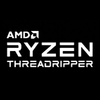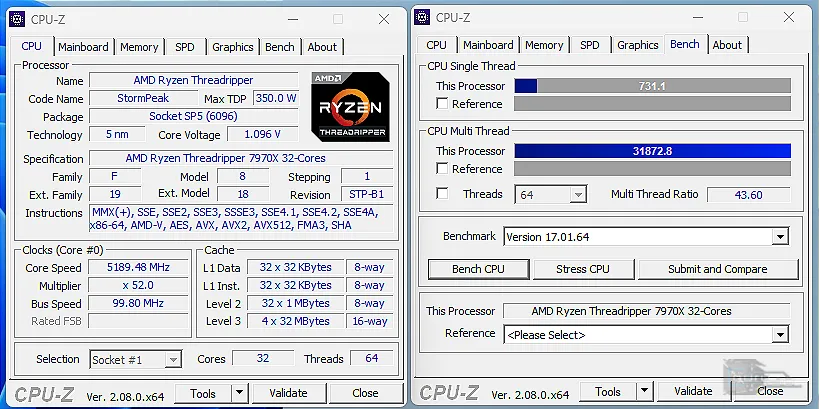Conclusion
Truth be told, with complete honesty, I'm surprised to see AMD launching new Threadripper processors for consumers and prosumers. The high-end desktop (HEDT) market, in my view, actually needs processors with up to 16 cores that offer faster per-core performance, rather than the 32/64 core versions which tend to be slower aside from accumulating them. Combine this with the exorbitant cost of these CPUs and their significant energy consumption (350W TDP), and it's quite baffling. So, unless you're working in 3D creation or have specific workflows that benefit from a high core count, it's questionable whether these will succeed in the consumer market. Nevertheless, this doesn't make the Threadripper 7000 any less impressive, as the performance values we're seeing are quite remarkable. While single-threaded performance is decent, the real advantage becomes apparent with software applications that utilize all 128 threads. Commendable is the fact that the new processors run well and are stable. Heat also can be managed despite that horrendous TDP. Remarkably, the 64-core processor draws the same power as its 32-core counterpart. The trade-off is a reduced base frequency, yet the performance surge when all 64 cores engage is formidable, provided the software can utilize many threads. Our benchmark suite highlighted that some programs are limited to 16 or 32 threads, which was not surprising. However, numerous applications did leverage the additional threads, yielding significantly better results. Yes, eight 8-core dies plus an I/O die introduce their own complexities regarding efficiency, scaling, and latency. Still, AMD has adeptly minimized most inefficiencies. It's unprecedented in the consumer market to access processors with 24, 32, and 64 cores, a domain once exclusive to the costly server segment led by Intel.
Application Performance
If the software application is designed to utilize 64/128 threads, this processor is fully capable of maximizing thread performance and delivering impressive results that will capture your attention. The processor is composed of eight 8-core dies, known as chiplets, along with an I/O die. Such a complex design can encounter latency and scalability challenges. Doubling the core count from say 16 to 32 to 64 will not necessarily double performance exponentially, but significant gains can still be expected if the software is optimized for it. Latency issues are mitigated by large on-die caches and the swift PCIe 5.0 interfaces. AMD has applied a hefty 350 Watt TDP across its 24, 32, and 64 core processors, which is significant given the varying number of CPU dies; the 32-core model has four active, while the 64-core has eight active. However, scaling efficiency isn't linear, as evidenced by reduced base clock speeds to accommodate the same TDP. For instance, under full load, the 32-core 7970X runs at 4.0 GHz and a 5.3 Ghz Turbo, whereas the 64-core 7980X operates at a base clock of 3.2 GHz with a 5.1 Ghz Turbo for a few cores. This 800 MHz base clock difference per core is substantial when multiplied across all 64 cores, explaining the scaling dynamic. When fewer threads are active, turbo speeds of up to 5.1 GHz can be reached. Observing the many core performance is truly remarkable.
Gaming performance
Obviously this platform has nothing to do with gaming, but if you want to, you can. While 3DMark showed very odd results the actually games perform well, not super great bit more in that mainstream segment of CPUs. I mean If you spend $2,499 (32-cores) or $4999 on a 64-core processor solely for gaming, it's not the wisest investment. However, the scenario changes if your primary concern is managing complex tasks with the occasional gaming on the side. Most games, however, run well and match the performance levels of your average Ryzen 7000 processor. There might be instances where a game cannot fully utilize the processor's capabilities though While sheer gaming performance isn't the primary reason to purchase such a high-core-count processor, the frame rates achieved are still fairly high.
DDR5 Memory
When considering a transition to an entirely new platform, the total cost of ownership is a significant factor. Even though the price of DDR5 memory is projected to decrease in the upcoming year, current market rates reflect a premium. For both Intel and AMD, a 6000 MHz configuration might offer optimal performance. In terms of stability, tests with a ~6000 MHz kit indicated consistent and reliable results. And considering what 4x16GB DDR5 costs these days, it's highly recommended.
Energy efficiency
The Threadripper 7000 series processors, with a TDP rating of 350W, deliver substantial performance but are energy-intensive. At idle, power consumption hovers around 150W, and under full load with all 64 cores active, this figure escalates by an additional 350W, resulting in a total power draw of approximately 500W. The duration of specific power states, which can be prolonged or shortened, depends on the motherboard BIOS settings. These extended power states not only increase energy consumption but also generate more heat. Nonetheless, cooling this processor presented no problems. Utilizing a 360mm Liquid Cooling System (LCS) from brands such as Corsair or NZXT, peak temperatures are maintained around 90°C. Generally, operational temperatures tend to remain near 80°C. However, idle temperatures were somewhat elevated, often reaching the 40-50°C range. We do have to note that IDLE energy power consumption was stuck at a silly 150 Watts, hopefully some motherboard BIOS updates will fix that.
Tweaking
We had massive issues overclocking Threadripper 7000, not so much because of the processors' capability to do so (neither the motherboard) it's just that under normal load the system already pulled over 500 Watts, and overclocking resulted in immediate shutdowns of our Kilowatt PSU, that or a Thermal shutdown on the CPU. For the Threadripper 7980X we left things for what they were, for the 7970X however we've been able to hit 5200 MHz on all 32-cores ... that yields this:
So for the 7970X we move towards ~ 32K points coming from 29K, say 10% extra performance.
Conclusion
Observing 128 threads in action and witnessing benchmarks complete in the blink of an eye is truly remarkable. It's challenging to find enough superlatives to describe this product. Nonetheless, the latest Threadripper CPUs cater to a niche audience within the consumer and prosumer markets. It's meaningful to estimate its intended user base. Aimed at the pro-consumer and small office/home office sectors, it remains a product for the few. AMD's release of the 64-core variant may seem like a bold move against Intel, but there is a definite user base for it. Imagine encoding videos or rendering 3D content on 64 cores—tasks that usually take a day could be reduced to mere hours, enhancing productivity significantly. Moreover, for virtualization, this processor is unparalleled. Take a 64-core processor with 256GB of RAM; you could set up 16 quad-core virtual private servers, each with 16GB of RAM. Power consumption then, our tests showed a system power under full load at approximately 500 Watts, breaking down to roughly 8 Watts per core. This is in stark contrast to Intel's Core i9 models, which consume more per core. The Threadripper's TDP (Thermal Design Power) may seem high at 350 Watts, but in practice, it's energy-efficient on a per-core basis. Regarding cooling, a 360mm liquid cooling system sufficed, keeping a fully stressed 64-core processor at around 80-90°C, which is impressive for such a high TDP many core processor. While Threadripper's most powerful processors may be relevant for only a small segment of the market, they have a substantial impact. For the average user, a Threadripper will be overkill, but for businesses and prosumers with demanding, high-thread-count workloads, processors like the Ryzen Threadripper 7970X/7980X represent remarkable value. That 7980X at 4999 USD, well yeah, it's expensive, but it redefines value in the realm of high-core-count CPUs. Hence, it earns a top recommendation for its groundbreaking performance and innovation.
- Sign up to receive a notification when we publish a new article
- Or go back to Guru3D's front page.



